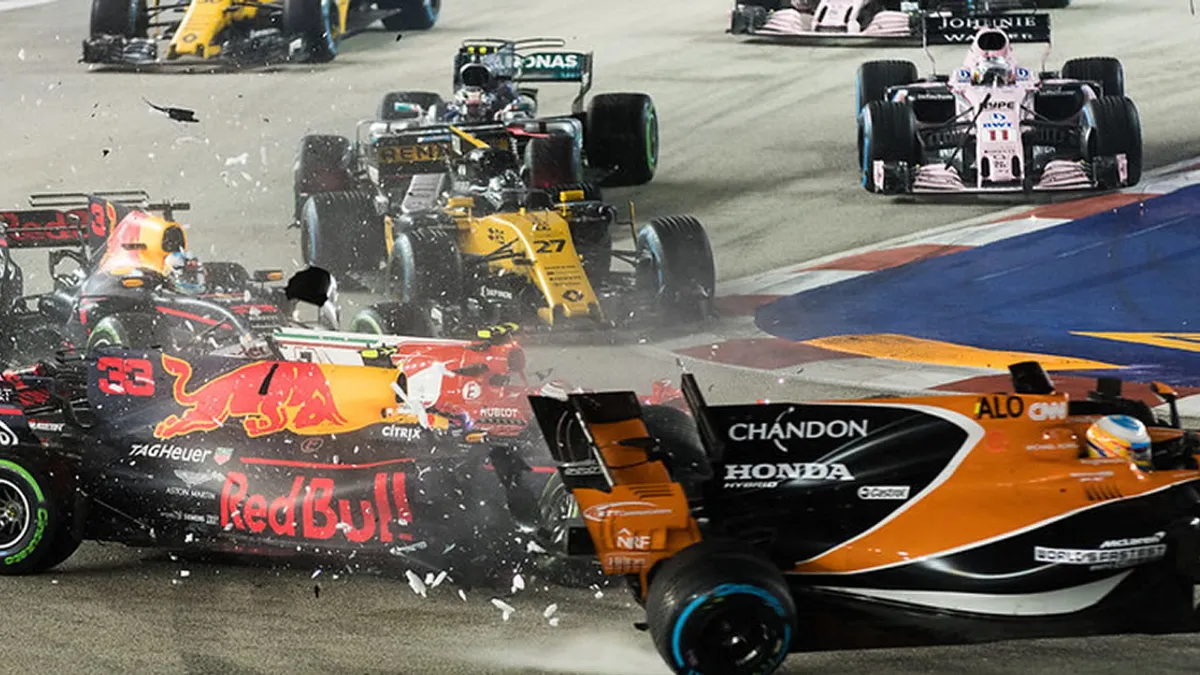

Safety in F1 – What has changed?
The recent Bahrain GP crash in which Romain Grosjean was involved highlighted the importance of the topic that has been highly debated upon in F1, i.e. the safety of drivers or safety in F1 in general.
Even after a massive 53G impact and being trapped in an inferno for nearly 20 seconds, the driver was relatively unscathed. After the car hit the guardrail, it split into two, with the front half ripping the guardrail like a can opener and the other half containing the fuel cell, which upon splitting caused an explosion, engulfing the whole car in flames.
Such an incident in the pre-2018 car would have easily turned fatal for the driver. The difference between the level of safety in any old F1 car and the modern, hybrid era F1 car is astronomical.
There have been some incidents in F1 that are primarily responsible for increased safety. For eg, Ayrton Senna and Roland Ratzenberger’s death in 1993, Jules Bianchi’s crash in 2014. So what is it that saved the life of Romain Grosjean, and what other advancements have been done in F1 since its beginning? Let us see.
Marshals
The involvement of marshals in motorsports as an aspect of safety is highly overlooked sometimes. Marshals are unpaid volunteers who are highly trained in first aid and incidents such as fire and complicated accidents.
They have been around since the start of F1 in the 1950s, and even put their lives on the line. There have been instances in the past where marshals have lost their lives or have been injured seriously.
They are also responsible to clear out debris incase of an accident, or contact, as the lying debris can damage the tyres of oncoming cars and can lead to another incident.
One more responsibility of Marshals is waving flags to alert the drivers of any incident or penalty. Even in Romain’s accident, the marshals helped to extinguish fire.
Helmet
The head is the most important part of the body and it has to be protected at any cost. In a formula car, the head of the driver is fully exposed, unlike a normal car. At 350Kmph even a small piece of debris is incredibly lethal.
At the beginning of championship in 1950, drivers wore cloth caps with goggles which offered no protection at all. Cork helmets became mandatory in 1952.
With time the championship embraced full-face helmets and in 2001 carbon fibre helmets were introduced. In today’s day and age helmets undergo stringent test and are highly fire-resistant, which showed in Grosjean’s crash as he had no head injury, nor did fire have any impact on his face.
Fire-resistant race suits
If you take a look at what drivers wore back in old days, you will notice a drastic contrast to what they wear today. Drivers had on them the apparel of their choice. Back then cars were incredibly physical to drive, so the goal was to move as freely as possible.
FIA made overalls compulsory in 1963 while from 1975, fire-resistant was obligatory. As technology evolves suits of modern eras are made of lightweight and breathable material.
The suits are such that they can tolerate the extreme heat of more than 600 degrees, which was quite clear from Romain’s accident. He was trapped in a fire for 20 seconds and still minor burns just on the hands, as the gloves can withstand only 10 seconds of fire.
The survival cell
The survival cell, or also known as the monocoque, is the part of the car that is nearly indestructible. With time it has evolved to protect the driver from the most diabolical crashes. It is situated at the center of the car and is also the part where the driver seats.
Constructed of strong carbon fibre which is 6mm thick, it also consists of a layer of Kevlar. It can absorb an incredible amount of energy and is also penetration resistant. As it is such an important part, it is tested thoroughly.
It is also fitted with a fire extinguisher, which can be activated by driver or also externally. It sprays fire retardant chemicals around the engine and monocoque.
The pitlane speed limit
An accident occurred at the 1994 San Marino GP in the pitlane which led to 3 mechanics being injured. After this pitlane speed limit was introduced to protect both driver and pit crew.
The current speed limit is 80 kilometers per hour with the race director having the authority to amend if needed.
Teams are penalized between 100 euros to 1000 euros for violating the limit, with additional penalties if required.
Barriers and run-off areas
Till 1967 until its ban, hay bales were a common sight. Results were obvious during a crash, increased chance of fire. Standard tire barriers were introduced in 2000 which prove useful in a crash like Charles Leclerc’s at Monza in 2020.
The Techpro barriers that are currently being used are also extremely technologically advanced.
After the fatal incident at Imola 1994, dangerous corners were made safer. Asphalt run-off areas were constructed in new tracks, which also sparked the debate of track limits.
The flip side? These new circuits, such as Sochi are accused of dull racing due to the safety parameters. The legendary Dutch circuit Zandvoort which was about to make its comeback in 2020(which got cancelled due to the ongoing pandemic) was also adjusted by the inclusion of new runoffs.
With time, the cars kept getting faster, and the G forces they pulled at a corner increased drastically. Modern era F1 cars are so fast that drivers pull G forces of up to an enormous 6G.
The neck is highly vulnerable to injuries in such a situation if left unsupported. Therefore headrests are required along with extremely strong neck muscles which were introduced in 1996. They are designed with a material that prevents whiplash and also absorbs impact.
HANS device
Another step taken towards the safety of neck and head was the introduction of the HANS (Head And Neck Support) device in 2003. In an event of a crash, it limits their movement.
The device is attached to the driver’s helmet and has a collar made of carbon fibre which prevents hyperextending of the neck which has caused numerous racing deaths.
Ban on Refueling
Incidents such as Jos Verstappen’s in 1994 and Raikkonen’s in 2009, led to a ban on refuelling in 2010. After that, drivers race with a fixed quantity of fuel in the tank.
The HALO
At the time of its introduction in 2018, it was highly controversial. Many fans and F1 veterans alike argued that it would go against the DNA of single-seater racing.
But the concept of cockpit protection came back in limelight after Jules Bianchi’s fatal 2014 crash. The HALO was chosen in front of aero screen and shield.
If there is any single thing that Romain Grosjean should thank for saving his life, it has to be the HALO. If not for HALO, his helmet would have made direct contact with the guardrail. There have been many other incidents in the past in which the damage could have been minimalized. For example Henry Surtees’s death in F2.
Another safety innovation that came in 2018 were gloves with biometric sensors, capable of monitoring drivers pulse and blood oxygen levels to race control. These are useful for monitoring driver’s health after a crash
So with these safety measures, F1 has never been this safe. But as we know there can never be enough safety. Grosjean’s accident proved this, the guard rail is not supposed to rip like that, nor should the car split in 2 on impact.
Therefore we can say that safety in F1 is continuously evolving. Investigating accidents like these will help us to enhance the safety quotient in Formula 1 to a great extent.
Written by – Tanay Lavingia
Compiled by – Tirth Pandya
Related posts


All-new i20 - First Drive Review

Skoda commences booking for Rapid AT





